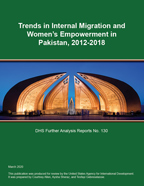
Abstract:
Background: For nearly three decades, gender equality and women’s health and well-being have been priorities on the international agenda. Empowered women have better health outcomes, such as the use of modern contraception and skilled birth attendance, and women who migrate can access opportunities that minimize inequality. Pakistan, the fifth most populous country in the world, is ranked low on the two indices that rank country progress in gender equality, the Gender Inequality Index and the Gender Development Index. This study describes and examines internal migration’s relationship with empowerment of women.
Methods: This study analyzed data from currently married women who ever migrated in the Demographic and Health Surveys conducted in Pakistan in 2012-13 and 2017-18. We describe migration flows of currently married women who have ever moved internally within Pakistan, as well as trends of high empowerment in three empowerment domains: attitude to violence, social independence, and decision making, by background characteristics. After testing for difference of proportions, we illustrate trends over time in figures that display significant changes between surveys. We conduct multinomial logistic regression to compare the most empowered and moderately empowered with the least empowered women in terms of empowerment’s relationship with our key independent variable, migration, while controlling for age, working status, region, and wealth.
Results: Some migration distinctions are significantly associated with high empowerment. Rural-urban migrants have decreased risk of high empowerment in the social independence domain, while urban-rural had an increased risk in the 2017-18 Pakistan Demographic and Health Survey. In the 2012-13 Pakistan Demographic and Health Survey, urban-urban migrant women had higher risk of high empowerment than their non-migrant counterparts in two empowerment domains: attitude to violence and decision making. Wealth and age were strong determinants of empowerment.
Conclusions: Overall, we find that migrant women who originated in urban areas had positive associations with empowerment and that rural-urban movers were disadvantaged. Though women can access opportunities to better empower themselves through migration, migrant woman may also be disadvantaged and vulnerable. Policy makers should focus on creating pathways that increase the success of women’s migration strategies.
 Trends in Internal Migration and Women's Empowerment in Pakistan, 2012-2018 (PDF, 2566K)
Trends in Internal Migration and Women's Empowerment in Pakistan, 2012-2018 (PDF, 2566K)
